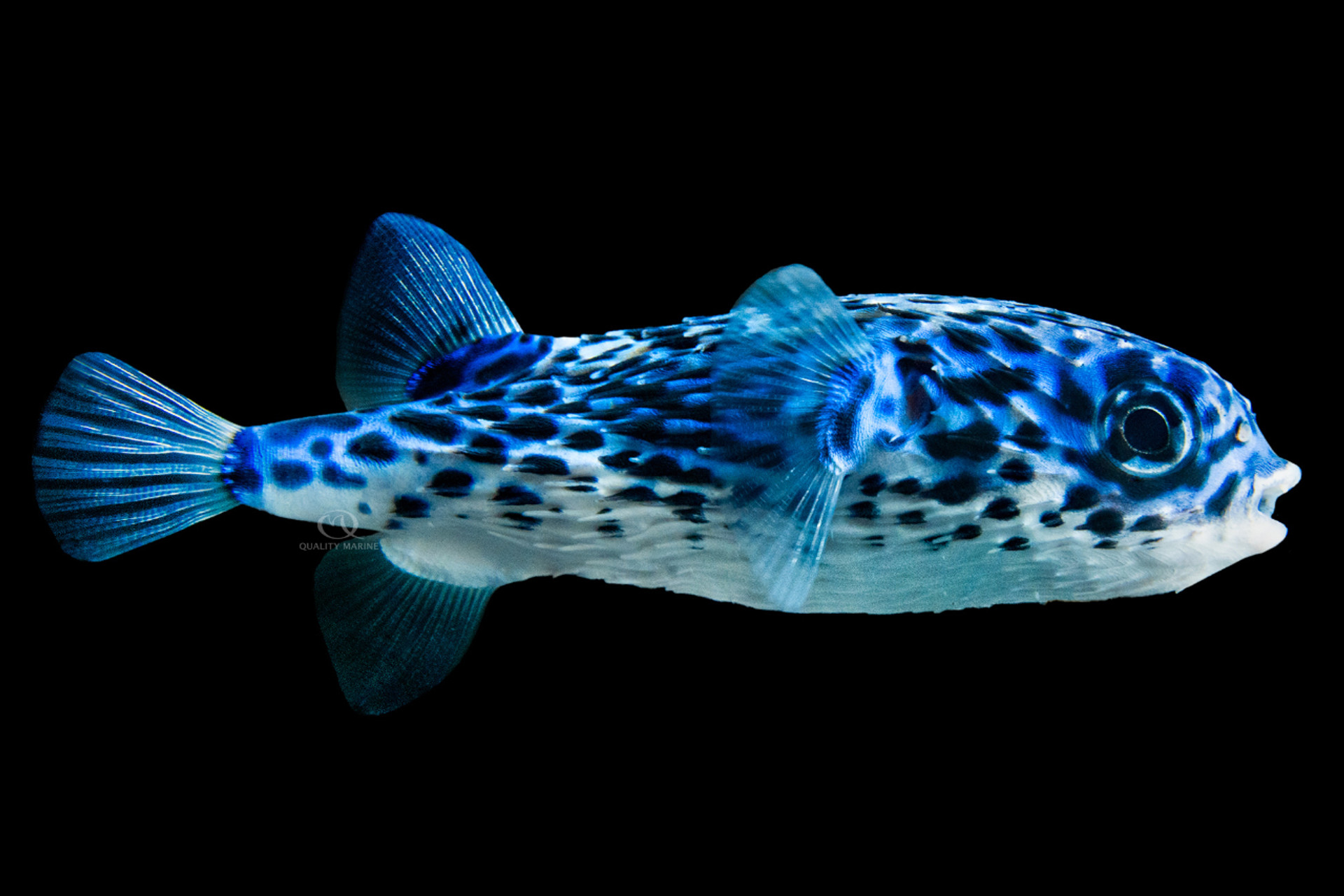The Deep Blue Puffer

If this is the first article you've read here at www.qualitymarine.com, welcome. You're going to quickly learn that we are huge fans of Pufferfish of all sorts and sizes, even those of the freshwater variety (check out our sister site at www.aquatropic.com). Puffers are the kings of personality, they are incredibly engaging with their keepers and once they recognize you as a food source, will be visibly excited to see you at the aquariums edge. Puffers in aquariums remain relatively rare, even though they are easy to keep, which makes them even cooler in our opinion.
When it comes to the pinnacle of cool and rare, we need to introduce you to a Puff that maybe you haven't even heard of before. Among the scientifically minded, it goes by the name of Diodon eydouxii; more commonly it gets called the Blue Pelagic Porcupine Puffer, or sometimes just Pelagic Porcupine. It gets called this because it doesn't stick to a range on a specific reef and can be found in every tropical ocean around the world, and almost always very near the surface.
The first thing that's going to stick out about this Porcupine Puffer is its azure blue color. The next thing you’ll notice is that they are small. Even fully grown this fish will rarely get bigger than a foot or long, and eight to ten inches is a much more common adult size. This correlates to an aquarium that also doesn't need to be as big as many of the other, more commonly seen Pufferfish. That being said, we suggest an aquarium of at least 125 gallons to give them some room to swim and grow, and more is always better. We always recommend glass aquariums for Pufferfish, as their prominent teeth can leave deep scratches in plexiglass. You can still use plexi, but you'll occasionally need to do repairs, which can be a chore. Blue Porcupines are messy eaters that require pretty strong filtration (and regular water changes) but are also plodding swimmers that don't do well in strong current. The Blue Pelagic Porcupine Puffer is slightly more slender than other Diodon puffers and is a better swimmer given its ecological niche, but it still isn't going to win any races. You'll need to ensure that there is plenty of overturn in regard to the filtration, but balance this out with diffuse flow, perhaps by using baffles and/or multiple returns.
The aquarium should feature plenty of rockwork, with caves and swim-throughs for the Puff to explore and hide in. Pufferfish are notorious for biting things to sample and find out whether or not something is food. This will include your rocks, so make sure all the décor in the tank is very secure. They have also been known to chew on air hoses and even heater cords, which can end badly. We strongly suggest that you keep your heater somewhere that is not accessible by the Blue Porcupine, like a sump or an overflow. They will not need substrate in the aquarium and are actually good candidates for bare bottom tanks, which makes it easier to clean up any uneaten food in the display. In time, the tank bottom will generally grow over with coralline algae, which looks great.
Making clean up easy is important because the natural diet of the Blue Porcupine Puffer is invertebrates, and this includes everything you might keep in a tank as a cleanup crew. They will happily chow down on snails, crabs, hermit crabs, urchins, sea stars and shrimp. You can still add all these things to a Pufferfish tank, but you should expect to do very regular replacement. Blue Puffs have the same, ever-growing teeth that other Diodon puffers do. This means a good portion of their diet should include some shelled inverts like Gamma Cockle In Shell and Krill. You can also feed them Gamma Mysis and Bloodworms. They will quickly learn how to take pellet foods, like Nutramar Complete. While this pellet will supply your fish with everything it needs nutritionally, they'll still need shelled food to wear down those choppers. You can also feed them market Mussels or Escargot and if you have a clean source for live feeder shrimp, they'll relish the opportunity to hunt these down too!
What else can you keep a Blue Porcupine Puffer with? There are options but trust us when we say that this fish is gorgeous enough and has plenty of star power to be the only inhabitant of an aquarium. If you do choose to keep other fish, make sure they are elusive enough to escape the Puffer, but aren't going to pick on it. Some Wrasses like all the Halichores fit this bill nicely, and Six-Lines are also great additions; wrasses are good at making sure that all the food scraps that the Puffer leaves behind get eaten. Several of the more peaceful Damselfish will also work. The other direction is to go with large fish, like Angels, Tangs and Triggers. This also works well but be wary of some of the more aggressive Triggerfish will pick on the Puffer.
Diodon puffers are very hardy fish, that aren't very picky in regard to water chemistry parameters and every aquarium keeper here can maintain what the Blue Pelagic Porcupine needs. A temperature in the low to mid 70s, pH between 7.8-8.4 and a specific gravity between 1.021 to 1.026. The water changes will need to be regular in the effort to keep nitrates down, shoot for a value under 15ppm and less is obviously better if you can manage it!
If you've been on the fence about getting a puffer, and/or are a bit of a rare fish enthusiast, don't wait, now is the time. Call your LFS and ask them about getting you a Diodon eydouxii from Quality Marine today, you never know when (if) your next opportunity to have Blue Pelagic Porcupine Puffer will crop up!